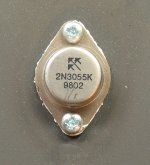I just found some panels loaded with 63 of these things. Mfr logo is 3 arrows pointing up and to the left. Date codes are 1998-1999, so they're not that old... Any idea who made them and what the "K" variant is? I find no data on it.
Attachments
Last edited:
I have seen the 'K' suffix for a metal TO3 case. Don't know if it is the case here.
What does Google say?
Jan
What does Google say?
Jan
Nothing specific, just datasheet links that go nowhere, one diya thread with a passing mention of a Motorola version, someone using that number for a license plate...
Hazarding a guess, Magnatec/Semelab/TT elelectronics version of epitaxial 2N3055 is rated up to 100V Vceo (max. working voltage) rather than the standard 60V. 'Could be that's all you might say was different from other generic 2N3055s but I'd test that voltage before trying my luck.
Last edited:
Thanks, I wouldn't be pushing them hard, just matching up pairs for a JLH amp. I tested a few, their Hfe's are all over the map, 50 to 250.
Try testing hFE closer to the working current (0.5A is Ic is sufficient). You may be surprised at the differences when reading Hfe of power transistors because the little testers and multimeter batteries that many of us are using, only supply a few mA current and aren't really telling you what you want to know under real conditions of use.
You'll need a heatsink with T03 mounting holes and a suitable (probably adjustable) DC power supply plus a power resistor for setting that more appropriate bias current. Supply voltage can be typically 20V but your amplifier's power supply may be OK too, as long as dissipation doesn't approach the transistor's SOA and the case temp. stays within safe limits.
hFE is then calculated from the base and collector currents.
You'll need a heatsink with T03 mounting holes and a suitable (probably adjustable) DC power supply plus a power resistor for setting that more appropriate bias current. Supply voltage can be typically 20V but your amplifier's power supply may be OK too, as long as dissipation doesn't approach the transistor's SOA and the case temp. stays within safe limits.
hFE is then calculated from the base and collector currents.
Thanks, I wouldn't be pushing them hard, just matching up pairs for a JLH amp. I tested a few, their Hfe's are all over the map, 50 to 250.
3055's are very ancient work horse in a time when such devices were few and far between. They are not very good in consistency, leakage specs, reliability and the gain starts to fall off very quickly with frequency.
I think it is a mistake to try to use them again out of a sense of nostalgia, unless it is for nostalgia's sake. But much better, modern devices are available with better high frequency performance and better out-of-the-box matching.
Jan
Try testing hFE closer to the working current (0.5A is Ic is sufficient). You may be surprised at the differences when reading Hfe of power transistors because the little testers and multimeter batteries that many of us are using, only supply a few mA current and aren't really telling you what you want to know under real conditions of use.
You're right of course, and I'm aware of that. Unfortunately, testing TO-3's at working current is a logistical pain. TO-220's and other flat packages are much easier to test quickly.
I have seen that the little testers can be used to match devices that have more linear current gain curves, such as MJ15022 and 2SC3281. Their gain changes little from 6.5mA to say 1A.
It is unlikely that a 3055 with Hfe of 220 at 6.5mA willl be linear to 1A, though.
I have a little curve tracer for small-signal transistors (Polar T1200) but it's no good for power devices. 50mA max Ic, if I recall correctly.
3055's are very ancient work horse in a time when such devices were few and far between. They are not very good in consistency, leakage specs, reliability and the gain starts to fall off very quickly with frequency.
I think it is a mistake to try to use them again out of a sense of nostalgia, unless it is for nostalgia's sake. But much better, modern devices are available with better high frequency performance and better out-of-the-box matching.
You're right of course, Jan. And I have better devices here. It's not so much nostalgia, it's more a case of, having found them, finding a use for them. I hate to throw useful stuff out.
#10 Use a 6-12v battery (or power supply). Install the transistor on the radiator. Connect to the emitter (-), connect a 1k resistor to the base and collector. Connect the collector through a multimeter in current measurement mode to (+). The ratio of the collector and base currents makes it possible to estimate Hfe.
You can use different resistors to measure at different currents. You can measure on panels 🙂
You can use different resistors to measure at different currents. You can measure on panels 🙂
Last edited:
And I have better devices here. It's not so much nostalgia, it's more a case of, having found them, finding a use for them. I hate to throw useful stuff out.
I had a friend who made some of them into cuff links. Really nerdy ;-)
Jan
You can measure on panels 🙂
Now there's a good idea - test before removing them! Also frees me from dealing with all of the silicone grease.
The Maplin disco 225wrms amp used 2N3055H and ran off 55 volt rails.
http://www.farnell.com/datasheets/89481.pdf
http://www.farnell.com/datasheets/89481.pdf
I had a friend who made some of them into cuff links. Really nerdy ;-)
Jan
That.
Is.
Awesome.
😀
- Home
- Amplifiers
- Solid State
- 2N3055K, what is it?
